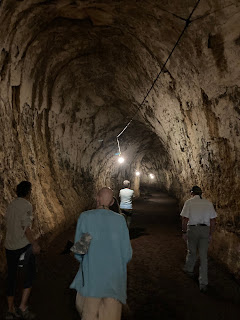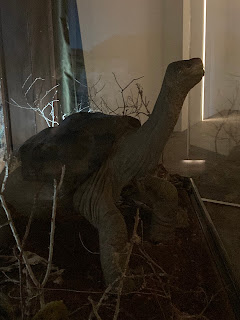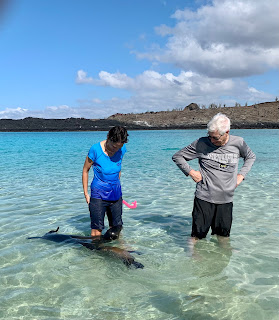We finished our journey with one final early morning, pre-breakfast hike. The boat had moved to Seymour Norte, a small island very close to the island of Baltra, where the airport is located. We had a dry landing on Seymour before sunrise.
The sea lions weren't up and around yet, but the beach was littered with them. We remarked about how excited we were to see a sea lion on our first day in the Galapagos. Now, we just walk by them -- paying as little attention to them as they usually pay to us.
Not so sleepy were the birds. The frigate birds were very much up and about, and what they were about was mating! The male frigates build a nest, then they sit in it and puff up bright red air bladder on their chest. When a female flies near, they also spread their wings and make considerable noise.
We saw many males waiting anxiously, but few females seemed to be paying much attention. We saw one female land right between two nests, which got both of the males very excited. We weren't sure if she was deciding between the two of them, or just teasing them both. She sat there and didn't make a move toward either one.
Also abundant on this island are Blue-footed Boobies. We've seen many of these, and noted that they are far more skillful flyers and fishers than their unfortunate name would imply.
When mating the boobies do a sort of dance, showing off their blue, webbed feet for one another. Our tour director described it as a "Hoky-Poky." "You put your right foot in, you put your right foot out, you put your right foot in and you shake it all about...." We were hoping to get a look at this, but the boobies we saw were not in a dancing mood this morning.
Our walk was cut short by the need to get back to the boat. We had a short time to shower, eat breakfast, and finishing our last-minute packing. As we did so, the boat motored the short distance over the Baltra where we would disembark.
We bid farewell to the crew, and took one last zodiac ride to shore. Our luggage came on the next trip. We had to wait some time for the bus, and several other boats disgorged their passengers on the same dock. But we were there first, and so got the first seats on the bus when it finally came.
We checked in at the airport, where our luggage was carefully screened to make sure we weren't taking sand, shells, rocks, bones, or pet iguanas with us. Very stiff fines are in store for any who violate these restrictions. Fortunately, all in our group followed the rules.
In Quito, we were met once again by Juan, our tour director for the mainland portion of the trip. He helped us catch a shuttle and checked us in to "day rooms" at the Wyndham Hotel right at the airport.
First order of business was to get rapid antigen tests for Covid so that we would be able to re-enter the U.S. OAT arranged for a couple of nurses to come right to a meeting room in the hotel, and the price was quite reasonable. Not surprisingly, we all tested negative.
We enjoyed a farewell buffet in the hotel restaurant, then had time to clean up and prepare for our longer flights.
A little after 9 p.m. we loaded up a different shuttle to go back to the terminal. Checking in meant waiting in long lines. It seems that all of the flights leave Quito in the middle of the night. Once through immigration and security, final farewells were said as we waited at the gates. Our group went out on at least three different flights on three different airlines.
Unlike our flight down, everything went smoothly on the way back home. No delays, even though Atlanta made us go through a very slow and inefficient security line once again after immigration and customs, for no apparent reason.
It was a cold morning in Minneapolis, but the Uber car arrived quickly and was well warmed up. We were home with the washing machine hard at work already by noon. There was no jet lag, as we'd not crossed time zones. But we were tired from a long night of flying and little sleep.
This entire trip was one of our favorites ever, but the Galapagos week really blew us away. It's truly been a spectacular experience.






























